Pinterest can transform a blog’s performance. Pinterest is more than just a social platform; it is a visual search engine that can direct a steady flow of traffic to your blog. These are tried and tested strategies that drive results. In this article, I explain 10 strategies to help boost your blog traffic using Pinterest. The focus is on actionable steps that you can start applying today. To give you an even deeper look at each approach, I have added further details and examples so you can make the most of each technique.
1. Optimize Your Profile for Maximum Visibility
Your first step when setting up a Pinterest business account is to treat your profile like a mini-website. Devote time to writing a clear bio and pick a profile picture that reflects your blog’s theme. You link your latest posts and key categories to make it easy for visitors to identify your value. Pinterest profiles that are complete tend to rank higher in search results. You always need to ensure that your profile is up to date and reflects the voice of your blog.
Then, focus on listing keywords that your target audience would likely use to find content similar to mine. You need to make sure that all information is accurate and relevant. This simple step can greatly improve the visibility of your blog on Pinterest.
How to Approach Profile Optimization:
- Update your bio with keywords that match your blog content.
- Use a clear, high-quality image for your profile picture.
- Include a link to your blog homepage and popular landing pages.
This foundation makes it easier for Pinterest users to trust and engage with your content.
Additional Insight: Taking the extra time to tailor your profile details not only improves search placement but also gives your visitors a clear idea of your expertise. Sharing a bit of your personality and consistent updates will help you build credibility and encourage repeat visits.
2. Create Engaging and High-Quality Pins
I believe that the quality of a pin determines how many clicks it will generate. High-quality images with clear focal points work best on Pinterest because they stand out in a crowded feed. Invest in creating or curating visually appealing graphics that are relevant to your blog posts. Detailed images that offer value can capture attention quickly. Also, pay attention to infographics or well-designed visual quotes that can intrigue a potential reader.
The main element here is consistency. You should maintain the same style, color scheme, and tone in your pins to ensure they represent your blog’s branding. This uniformity builds recognition and trust over time. Make sure that each pin clearly indicates what the linked blog post is about. Add a small logo or mark to ensure that if it gets reshared, the credit is maintained.
Recommendations for Creating Pins:
- Use high-resolution images that are vertically oriented.
- Keep text overlays concise and informative.
- Test different layouts and visuals to see what resonates best.
Experimenting and continuously improving your pin design can lead to an increase in engagement and traffic over time.
Additional Insight: Consider spending some extra time refining your graphics and updating them periodically. It is very important to stay current with design trends and user preferences. By testing multiple styles and gathering feedback, you can identify what truly works best for your audience, ensuring a steady improvement in your click-through rates.
3. Make the Most of Rich Pins for Better Engagement
Rich Pins provide more context about an idea because they include extra details directly on the pin. I have found that this additional information can turn casual viewers into readers. Product pins, article pins, and recipe pins are examples of richer formats available on Pinterest. They show details such as titles, author information, and even specific pricing or publication date details, which can drive higher engagement.
Integrating Rich Pins with your blog posts allows readers to quickly determine if the content aligns with their interests. Setting up Rich Pins requires some technical steps, but the rewards are visible in the increased credibility of your links. Rich Pins act as mini previews that help users decide to click through and learn more.
Steps to Follow to Set Up Rich Pins:
- Ensure that the structured data on your blog is correctly implemented.
- Use Pinterest’s validation tool to certify your pins.
- Monitor their performance and adapt your strategy based on analytics.
This process builds trust with your audience by offering more detailed previews before they even visit your blog.
Additional Insight: It is really important to spend time refining your technical setup when using Rich Pins. Once the initial configuration is complete, you can enjoy long-term benefits as your audience gains confidence in the detailed previews. Regular check-ups on your structured data help you stay ahead and continuously improve user interaction.
4. Use SEO Techniques to Step Up Pin Discoverability
Every pin on Pinterest is subject to search, and you should treat each pin like a mini landing page. Use descriptive file names, alt text, and keywords in the pin description to improve its chances of appearing in relevant searches. Treating Pinterest like a search engine optimization project yields benefits that extend beyond direct clicks. When your pins are well-optimized, they appear in both Pinterest search and general web search results, further expanding their reach.

Using appropriate tags and keywords increases the chance of your pins getting discovered by users looking for related content. Keep the language natural and straightforward. This strategy helps you to appear consistently in search queries relevant to your blog topics.
SEO Best Practices To Implement:
- Write clear, keyword-rich descriptions for each pin.
- Use board titles and descriptions that incorporate relevant terms.
- Regularly update your content to reflect recent trends in your blog niche.
Such practices not only boost your pin visibility on Pinterest but also on search engines and step up overall traffic to your blog.
Additional Insight: In order to truly step up your pin discoverability, consider experimenting with long-tail keywords and seasonal trends. Regular monitoring and adjustments based on performance data are essential. Small optimizations over time can have a big impact on how often your content is found by new viewers.
5. Organize Pins into Relevant Boards
Boards play a significant role in how you should organize your content on Pinterest. Create boards that segment your blog topics clearly and logically. Each board should be named with specific keywords so that both Pinterest and users know what to expect when they click on it. This organized approach gives visitors a quick overview of the themes you cover, making it easier for them to find content that meets their needs.
For example, if your blog includes topics on lifestyle, cooking, and travel, have separate boards for each. This categorization helps keep your profile tidy and user-friendly. A well-organized profile builds credibility, and I often notice that enthusiasts browse multiple boards when they trust a source.
Top Board Organization Tactics:
- Create board titles that are clear and indicative of the content.
- Add detailed board descriptions with relevant keywords.
- Regularly curate and update boards to keep them fresh.
A structured board system consistently helps your audience locate their areas of interest and has boosted engagement with your content.
Additional Insight: Taking the time to think carefully about how your boards are structured can make a huge difference in user navigation. Detailed board descriptions and regularly updated content can guide your audience to the posts they find most valuable, ultimately leading to more sustained traffic growth.
6. Get Involved with the Pinterest Community
Understand that Pinterest is a community, and your interaction with other users is important to your growth. Follow accounts that share similar interests and repin content that aligns with your blog’s themes. Commenting on pins and joining group boards provide valuable opportunities for connection. I see getting involved as a two-way street; when you interact with others, it creates interest in your content.
Interacting with pins that are relevant to your niche not only increases your visibility but also helps build relationships with fellow content creators. This involvement can lead to collaboration opportunities or even simple cross-promotion that benefits all parties involved.
Ways to Get Involved Effectively:
- Regularly repin and comment on high-quality, related content.
- Join group boards that align with your blog topics.
- Share detailed feedback and contribute to discussions on popular pins.
This active participation in the community strengthens your reputation and positions your blog as a trusted resource.
Additional Insight: Beyond simply repinning, make an effort to start conversations and ask genuine questions. This consistent interaction not only raises your profile among peers but also encourages visitors to check out your boards. Over time, these small acts of getting involved can snowball into substantial exposure for your blog.
7. Run Promoted Pin Campaigns Strategically
To boost visibility, run promoted pin campaigns when you have budget flexibility. Promoted pins are similar to ads and help you reach new audiences who might not otherwise see your content. It is helpful to define clear goals for each campaign. Whether it is to increase blog traffic or boost engagement on a specific board, carefully planned campaigns yield measurable results.
Setting a clear objective is very important. Monitor key metrics like click-through rates and conversions so that you can make necessary adjustments as the campaign evolves. Promoted pins also allow you to experiment with various pin designs and descriptions, and the data from these experiments helps refine future campaigns.
Guidelines for Launching a Promoted Pin Campaign:
- Define clear goals, such as increasing visits or engagements.
- Select pins that have performed well organically and consider boosting them.
- Review campaign data regularly to optimize performance.
This advertising strategy should directly increase your blog traffic and provide insights that inform your overall Pinterest approach.
Additional Insight: Before investing in promoted pins, it is very important to test your organic content to understand what resonates best with your audience. Once you identify a winning formula, scaling up through paid campaigns can give your blog the extra push needed to reach a larger audience. Regular reviews and adjustments ensure that your investment continues to pay off over time.
8. Analyze Pinterest Analytics for Data-Driven Decisions
Pinterest Analytics helps you to understand how your content performs. The platform provides detailed insights into pin impressions, clicks, and saves. With this information, you can identify which types of content resonate most with your audience. Check your metrics regularly and compare trends over time. This attention to detail helps you adjust your strategy and allocate resources where they matter most.
Data-driven decisions should be fundamental to your approach. For example, you may notice that pins with certain color palettes or themes consistently perform well. By identifying these patterns, you can produce more content that aligns with established strengths. Tracking the origin of blog traffic allows you to measure the return on investment for each campaign.
How to Use Analytics Effectively:
- Review key performance metrics such as click-through rates and saves.
- Identify trends in engagement and adjust content strategies accordingly.
- Make informed decisions about where to focus future efforts.
Regular review of analytics helps you refine your content and guides you in making adjustments that step up overall performance.
Additional Insight: In addition to basic analytics, pay attention to emerging trends and compare them with industry benchmarks. This extra layer of analysis allows you to spot new opportunities and tweak your strategy before your competitors do. Keeping a close eye on your metrics is a continuous process that ultimately drives informed and effective decisions.
9. Team Up with Influencers and Use Group Boards
Working with others can extend the reach of your blog posts beyond your existing audience. Seek opportunities to team up with influencers or participate in group boards in your niche. Group boards are a shared space where content from multiple contributors is visible to fans of the board. Joining established group boards can increase the chance that your pins will be discovered by users who might not see them otherwise.
Working with influencers familiar with Pinterest can also be beneficial. Their audiences trust their recommendations, and when they share your content, it can lead to increased traffic. Approach team-ups with clear communication and mutually agreed expectations to ensure that the partnership is beneficial. This strategy reinforces your position within your blogging niche and often results in complementary exposure.
Steps for Effective Team Up:
- Identify group boards that have active engagement and align with your themes.
- Reach out to influencers with a proposal that highlights mutual benefits.
- Create content specifically designed for collaboration that adds value to all parties.
By combining group boards with influencer team-ups, you can potentially reach audiences that were previously untapped.
Additional Insight: When considering a team-up, it is very important to ensure that both parties share similar values and content quality. A strong partnership is built on trust and mutual benefit. Over time, these collaborations not only expand your reach but also add a fresh perspective to your content strategy, making your blog even more appealing to new readers.
10. Use Pinterest Scheduling Tools and Maintain Consistent Posting
Regular activity is key to maintaining a presence on Pinterest. Use scheduling tools to plan and publish your pins consistently. This system saves you time and ensures that your pins are published at optimal times when your audience is most active. Automation does not replace the need for creativity, but it does guarantee that your content continues to reach viewers even when you are occupied with other tasks.
Tools such as Tailwind can help streamline your workflow. Schedule your pins in advance, review performance data, and adjust timings based on engagement trends. Consistency should be central to your strategy. When users expect frequent, quality content, they are more likely to follow your boards and visit your blog for new posts.
How to Stay Consistent with Scheduling:
- Plan a content calendar that maps out key topics and posting times.
- Use scheduling tools to automate pin publishing while maintaining quality control.
- Monitor analytics to adjust posting frequency and timing.
Regular posting combined with strategic scheduling helps keep your audience engaged and your blog traffic steadily growing.
Additional Insight: In addition to scheduling, it is very important to periodically review and update your content calendar. This ensures that your posting strategy aligns with seasonal trends and emerging topics in your niche. By planning ahead and staying flexible with adjustments, you can maximize the impact of your regular posting routine.
Final Thoughts
Pinterest is a powerful ally in driving blog traffic when used with a clear strategy. Each strategy focuses on visibility, engagement, and consistency, which are key components in building a robust blog audience. As you implement these strategies, keep in mind that persistence and thoughtful adaptation are very important. Your results may take time, but each improvement in your approach can lead to more visitors and increased engagement over the long run.
I encourage you to assess your current strategy and apply these methods gradually. Whether you are new to Pinterest or looking for ways to refine your approach, you may find that even small changes yield meaningful results. Pinterest gives you the opportunity to connect with a wider audience, and I believe it can offer the same advantages to you. I look forward to hearing how these strategies work for your blog. Remember to track your progress, ask for feedback, and continuously step up your efforts to keep your audience excited about what’s coming next.
Additional Insight: Remember that achieving success on Pinterest is a process that combines creative content, technical setup, and ongoing involvement with the community. Every step you take is a building block toward establishing a loyal following, and with dedication, the rewards will follow. Keep experimenting, stay flexible, and enjoy the ride as your blog grows one pin at a time.

